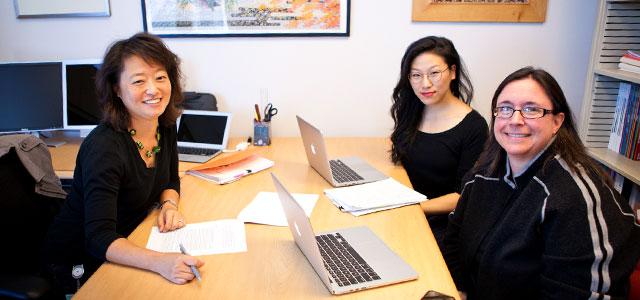
From left: Janet Shim, Jamie Chang, Leslie Dubbin (photo by Elisabeth Fall)
Potential Pitfalls in the Trend Toward Patient-Centered Care
Ask yourself: What would you do first after you or a loved one received a cancer diagnosis? What would you do second, and after that?
Would you search Google to learn more about the cancer, your treatment options and maybe even research trials enrolling participants? Would you line up a second opinion or even a third? Consult a spiritual leader?
Or would you feel lost, suspended in fear, hanging on the next word from a doctor?
Those types of questions are part of a “thought experiment” that UC San Francisco School of Nursing sociologist Janet Shim uses to define the concept of “cultural health capital,” a term she coined. It refers to the skills, resources, attitudes and styles that patients and providers bring to medical care – a kind of currency for getting needs met.
Shim and her colleagues Leslie Dubbin (a doctoral student at the School and director of clinical operations at San Francisco General Hospital) and Jamie Chang (also a doctoral student at the School) argue that cultural health capital plays a significant role in patient care, including outcomes. Further, they say, the trend toward patient-centered care – an increasingly popular approach that encourages providers and patients to share responsibility and power and has many benefits – too often disregards the influence of cultural health capital. The result: an uneven health care playing field that puts some patients at a serious disadvantage.
In June 2013, Dubbin, Shim and Chang published a study in Social Science & Medicine that they say supports their theories.
Challenges of Patient-Centered Care
“We wanted to temper some of the enthusiasm for patient-centered care,” Shim says. “There are some deeply held expectations, beliefs and convictions about what it means to be a patient and what it means to be a provider that can get in the way of providing patient-centered care. It’s really very complicated.”
Shim describes how her comfort with medical lingo, practices and institutions allowed her to assertively step in when her mother was diagnosed with cancer. People without a medical background, or knowledge or interest in tracking down health information, or a comfort level in asking for help on these things, might have a totally different approach.
“This is cultural health capital at work; it’s the way that you see or frame the problem that you need to solve,” she says. “Our expectations about what we ought to do and how we ought to act: they’re all systematically and unevenly distributed.” This distribution can contribute to well-documented health care disparities based on culture, race, gender and socioeconomic background.
The Study
Committed to reducing disparities, the School of Nursing researchers wanted data to determine if their fears that patient-centered care has equality risks could be substantiated. In their qualitative study, they recruited six physicians at three health care facilities in the western United States, and two or three of their patients with coronary disease and/or type 2 diabetes. Appointments were recorded.
 After the appointments, the researchers conducted detailed follow-up interviews with the patients and doctors separately. They asked the patients about such things as their understanding of their medical condition, their practices for seeking additional information, their expectations of their provider, and how they view themselves as patients.
After the appointments, the researchers conducted detailed follow-up interviews with the patients and doctors separately. They asked the patients about such things as their understanding of their medical condition, their practices for seeking additional information, their expectations of their provider, and how they view themselves as patients.
With the physicians, they asked about their expectations of their patients, their approaches to patient communication, their views of themselves as physicians, and their preferred patient characteristics.
Using a specially designed coding scheme, the trio of researchers analyzed the interviews to assess the influence of cultural health capital on the interactions and on the achievement of patient-centered care.
They found that cultural health capital does indeed have a strong bearing on how the patient-provider exchanges flowed, including on whether both patient and physician were satisfied that care needs were being met.
“And it’s not just about a patient’s individual skills and assets, per se. It’s about how they get used and how they are perceived on the other end, by the physician,” Dubbin says.
For example, she explains, one physician might appreciate a patient who aggressively jumps into her care, bringing in notes and papers she’s researched from lay sources, while a different doctor could find this an annoying waste of time.
“The achievement of patient-centered care requires mutual recognition and matching of social and cultural experiences, expectations and resources of both patients and providers.”
Today’s Health Care Environment Ups the Relevance
This is especially important in the era of health care reform. Institutions are rushing to find more cost-efficient ways to serve more patients and achieve better outcomes. Patient-centered care is seen as a way for providers and institutions to improve patient adherence to treatment plans – and to save money by cutting wasted time.
There are many positives to the model, including research showing patients who are driving their own care tend to have better outcomes, Dubbin and Shim stress. They view its focus on patient uniqueness and individuality as a step in the right direction for improving health care.
However, “there’s the other side of the coin,” Dubbin says. “As the institution becomes more efficient and time-conscious and value-added, all patients may not be on the same page as the institution. Those may be the very patients who fall through the cracks.”
Poorly equipped patients may not benefit as much, and neither will the providers who want the time and resources to partner with patients of all backgrounds, including those who are less naturally comfortable in a medical environment, say the researchers.
“In the US today, while providers are being asked to do more with less, patients are being asked to be not just patients, but consumers of medical services. To be a ‘successful’ consumer, one needs certain types of skills to participate, engage with, evaluate and/or question the care she or he receives,” Dubbin says.
Dubbin and her colleagues acknowledge that solutions for mitigating the effects of unevenly distributed cultural health capital aren’t easy or simple. At the moment, they are just trying to raise awareness, to stir thinking and discussion that they hope will lead to institutional efforts to find solutions.
“Making health care organizations think about the kinds of demands they make on patients and whether patients are disproportionally able to meet those demands, is a start,” Shim says.



